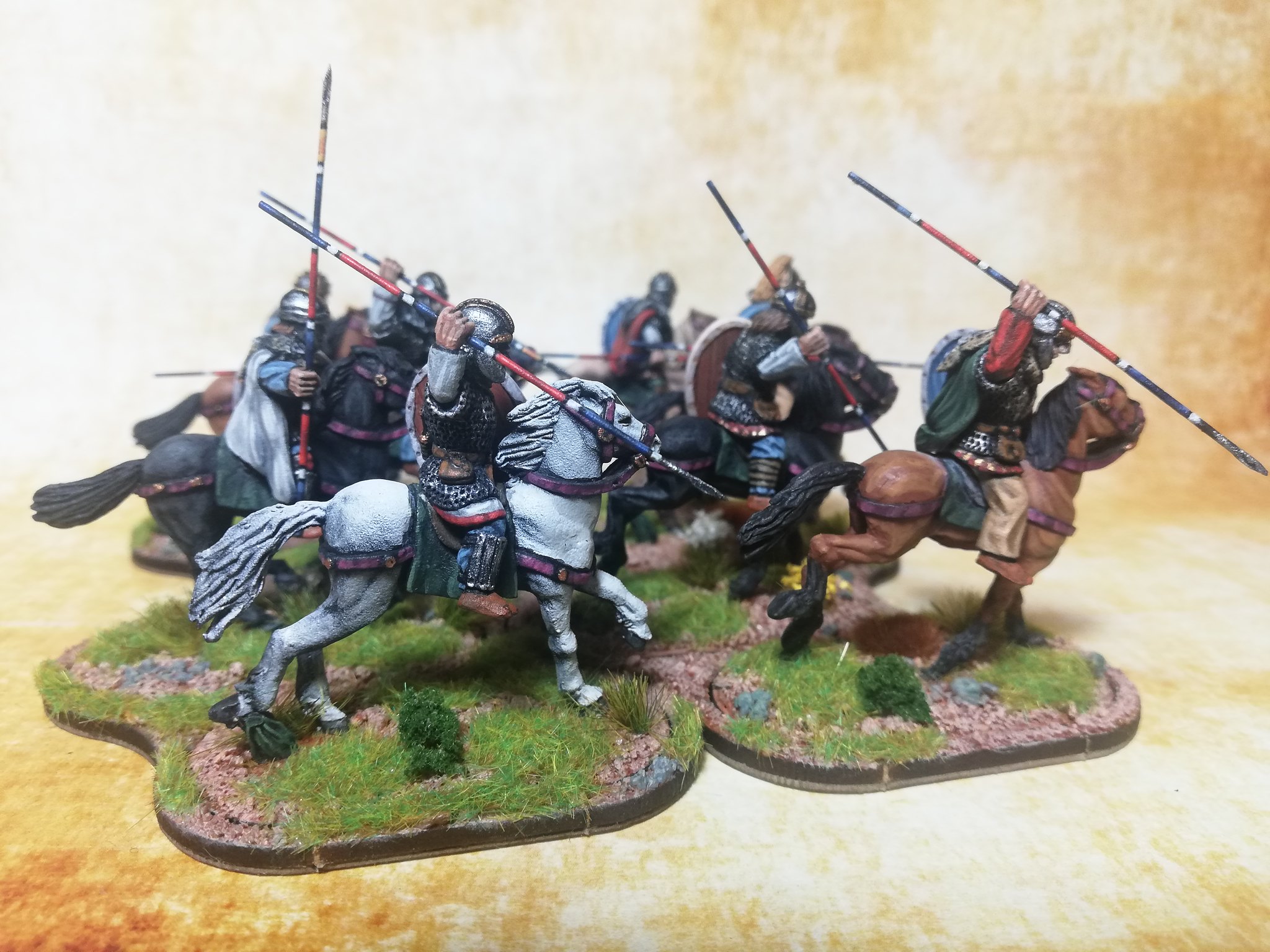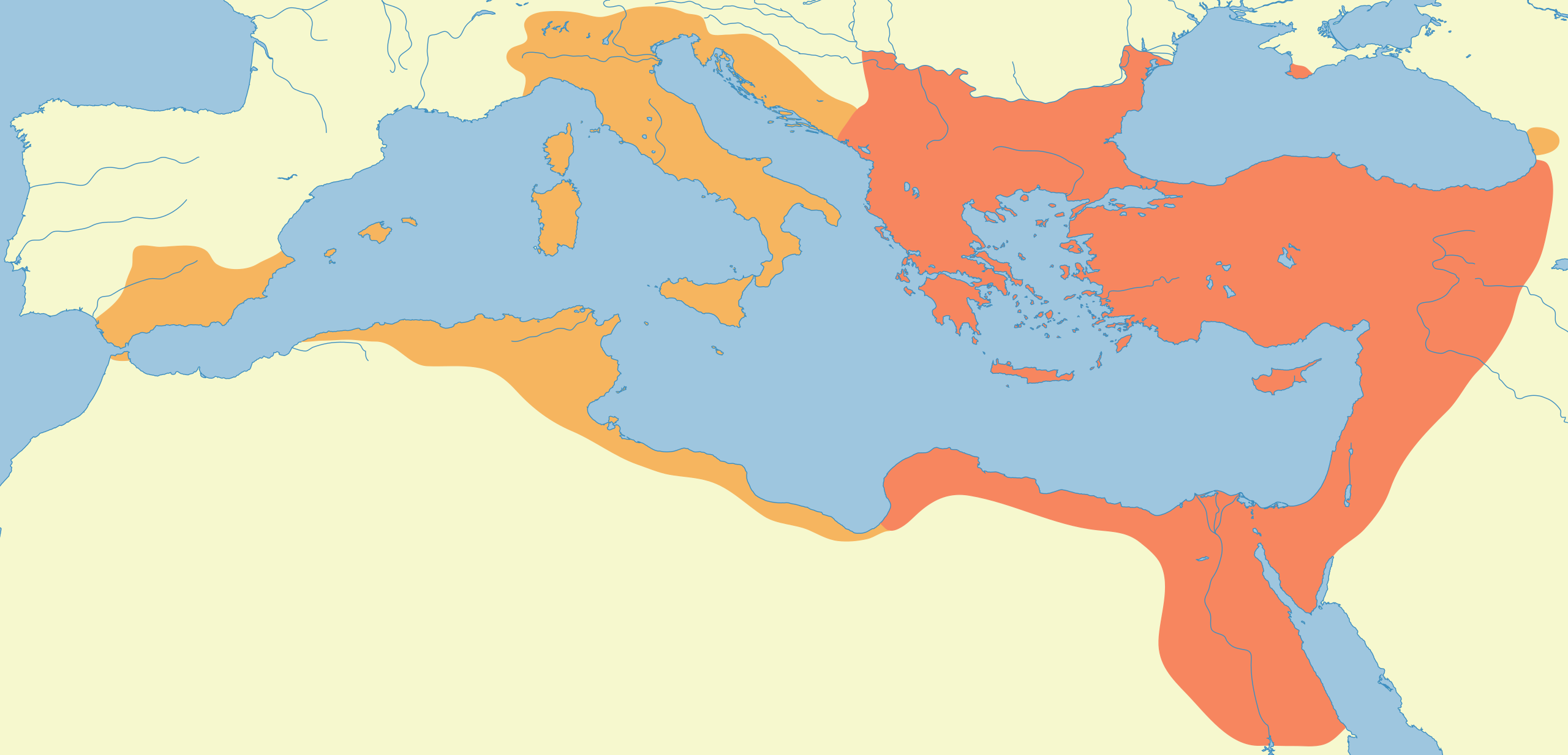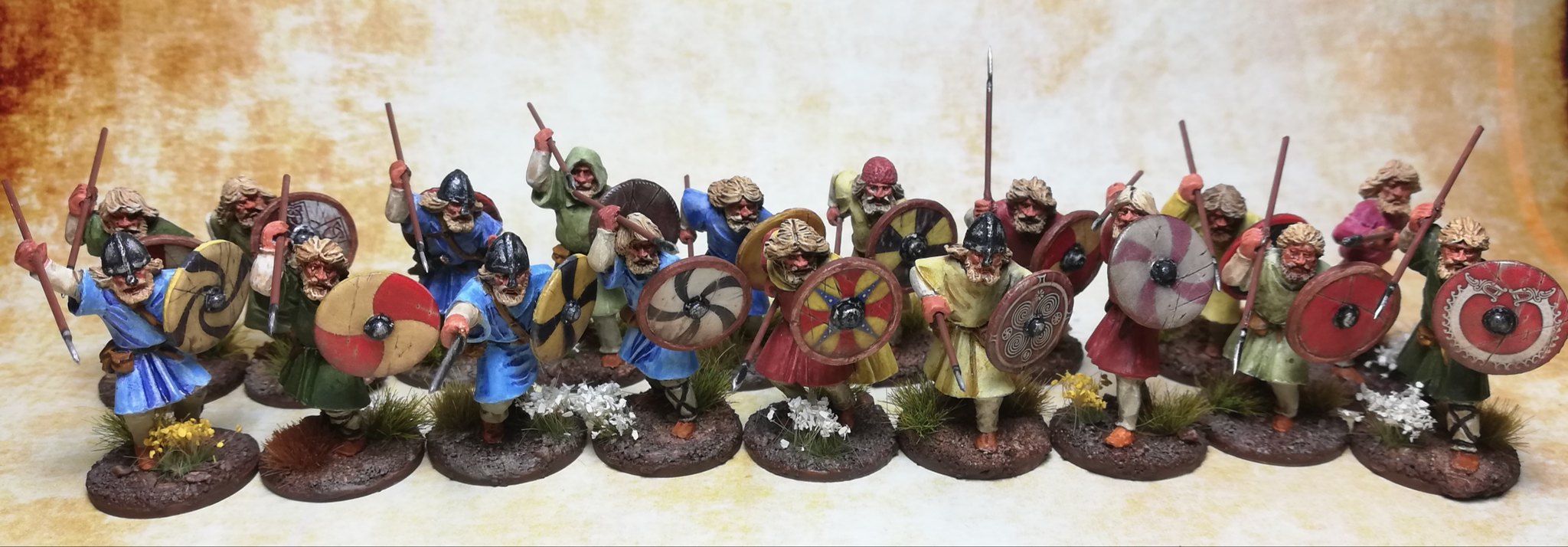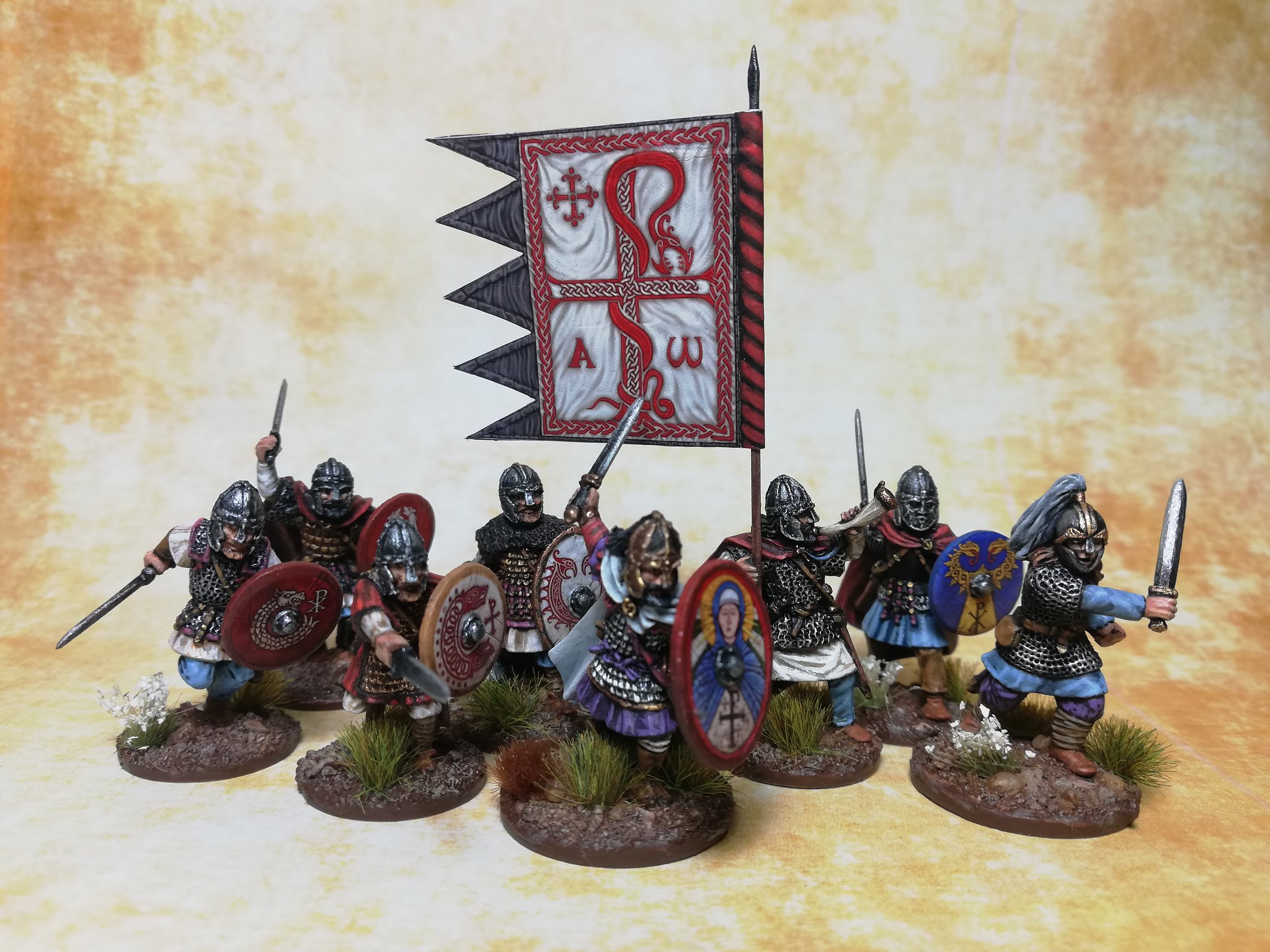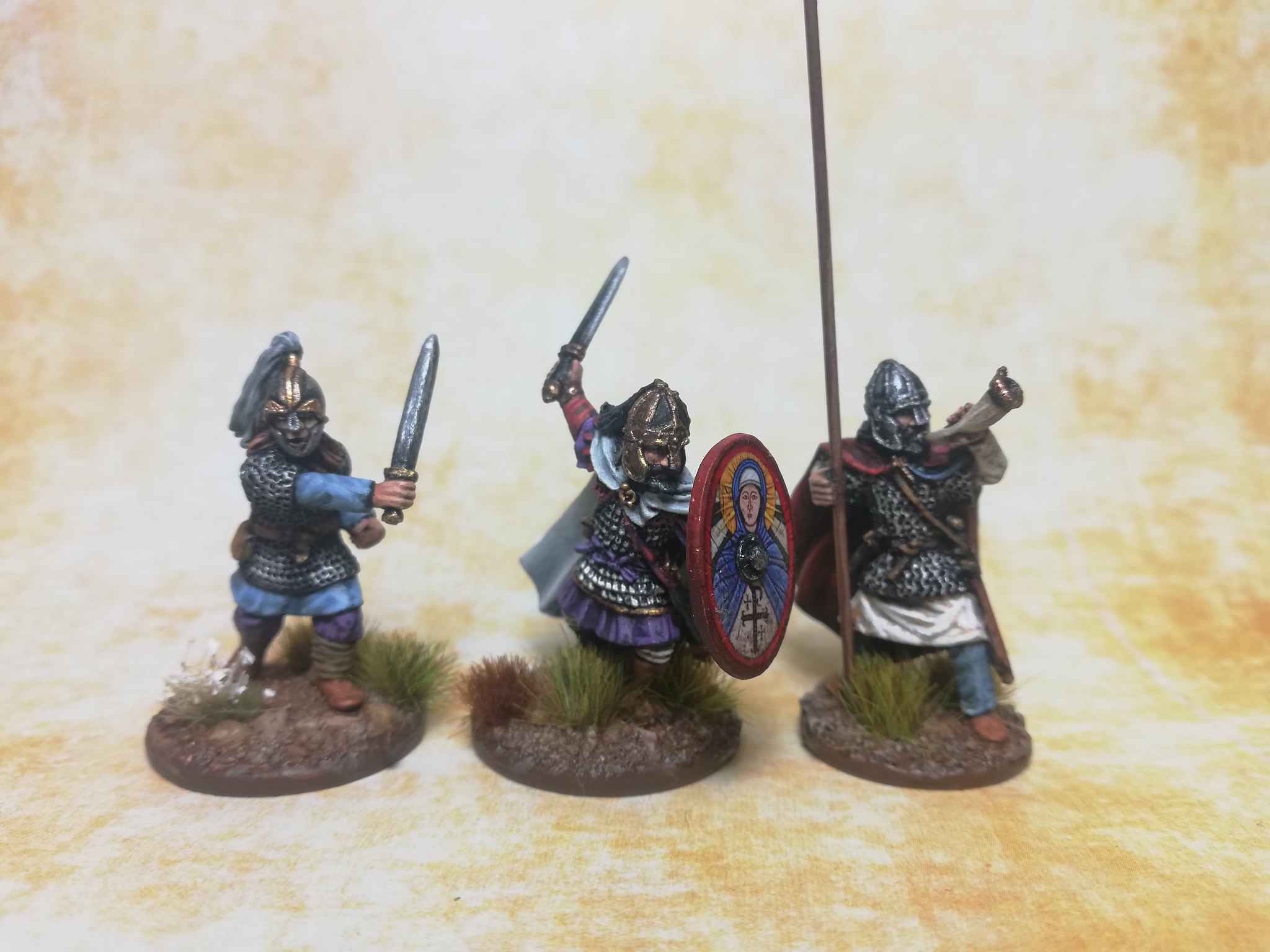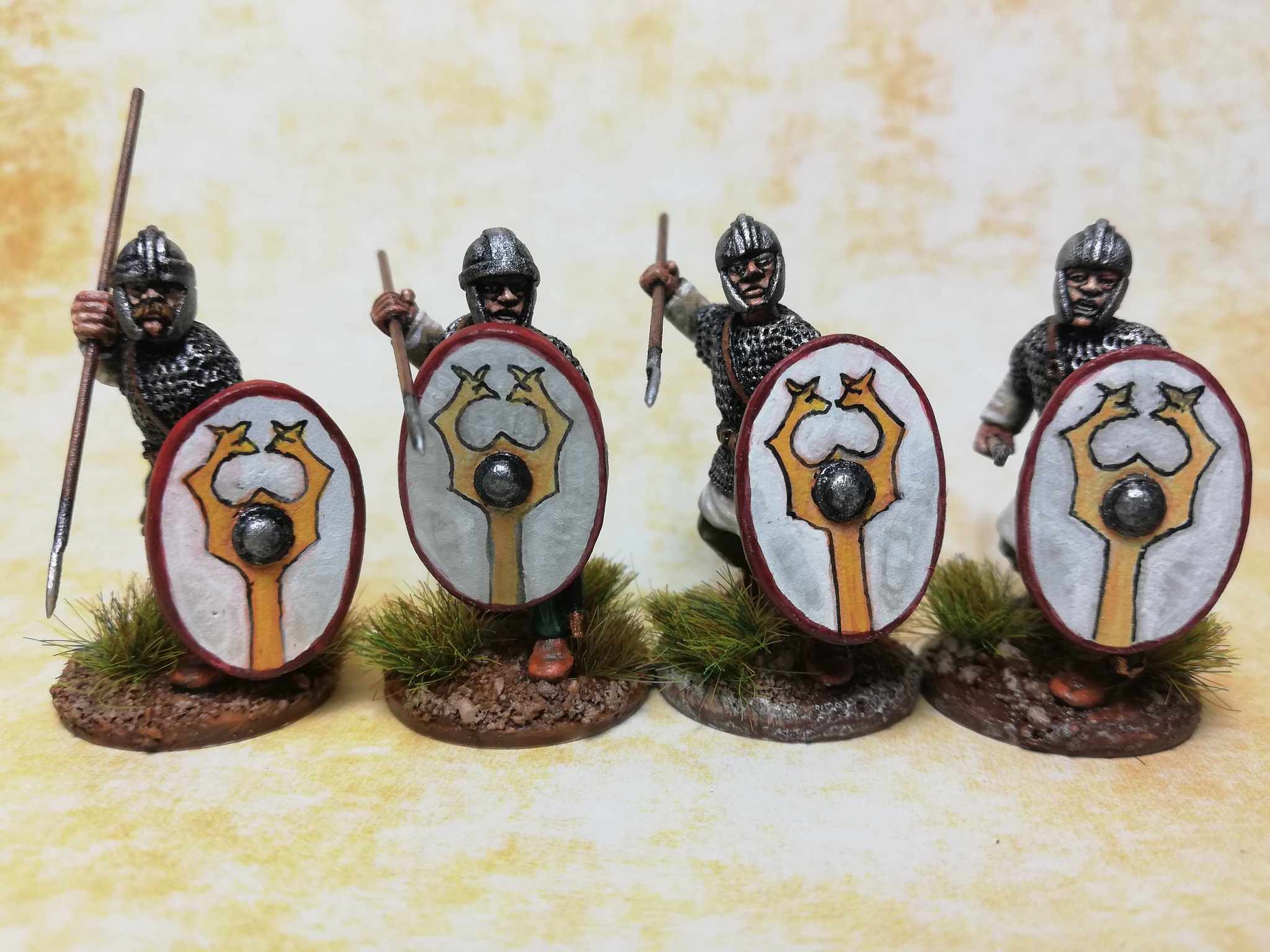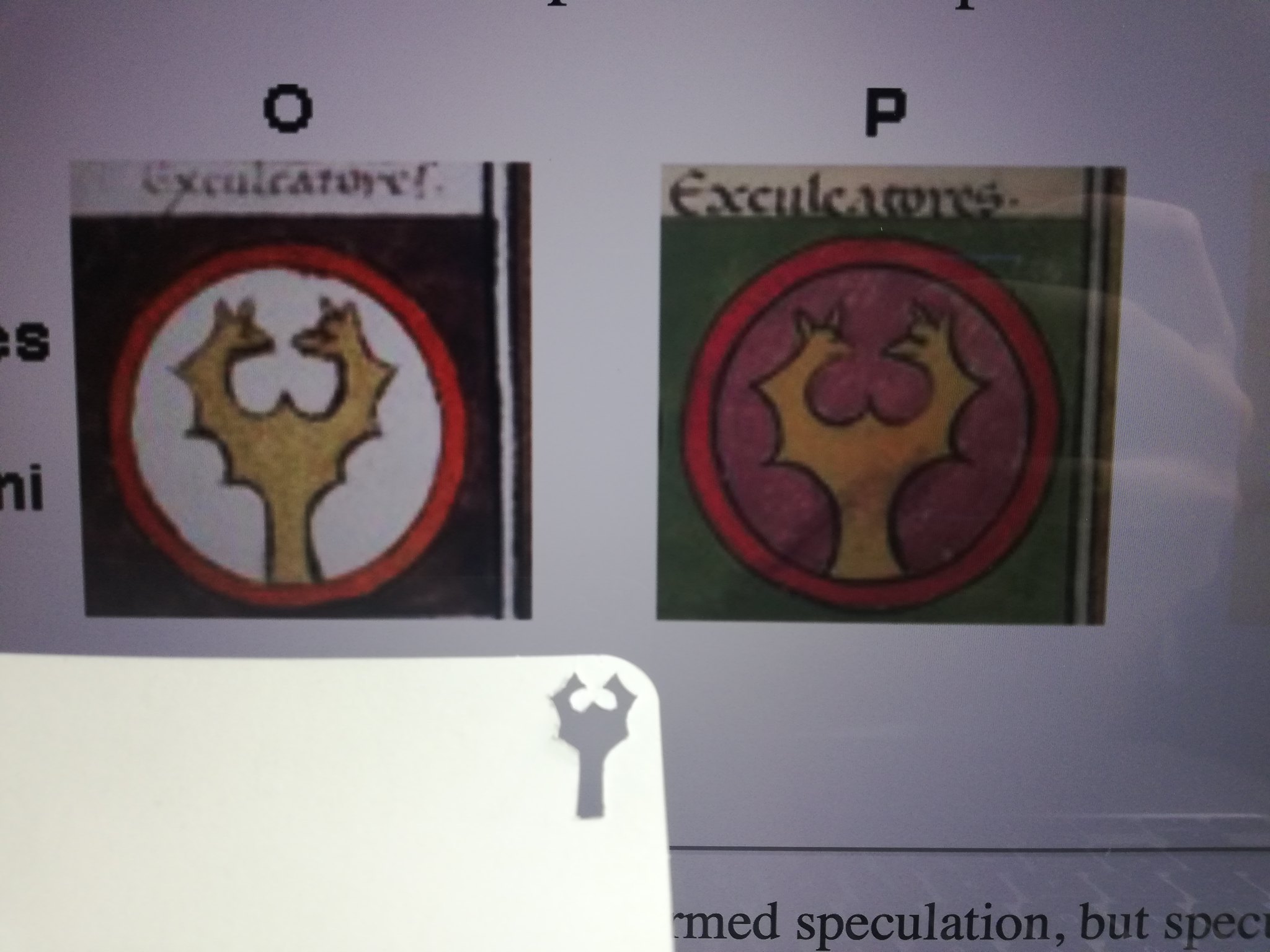It's been two months since my last completed unit, but I'm back with some major progress. Eight Romano-British cavalry from Footsore to bolster my forces.
They'll serve as Hearthguard for SAGA, Noble/Ordinary cavalry for Dux Bellorum and mounted Men of the North for Dux Britanniarum. The latter role inspired me to draw on the early medieval Welsh poem Y Gododdin by Aneirin for inspiration for the colour scheme of the riders and their horses.
These are the first cavalry I've painted since some Gary Morley Silver Helms way back in 1998 - 21 years! :D
Back to history. There is a wealth of guidance for painters in the text of Y Gododdin which I've compiled below in case anyone is interested.
Y Gododdin
Costume Notes
Numbers in parentheses refer to stanza followed by line.
Broad lightweight shield (1:5)
Gold-bordered garments (1:8 )
Betorqued (many)
Mail-coat (3:7)
Lime-white shields (11:6)
Blaen took delight in gold and purple (16:6)
Gold-fretted shield (29:3)
Swift steeds and dark-blue war-gear and shields (33:2)
One who wore purple (67:4)
Ice-bright shields (71:13)
Horses
Roan (26:8 )
A trim long-legged grey (50:4)
Darker (brown) his saddle (50:6)
Grey steeds (58:11)
Red steeds (61:7)
White horses (74:5)
Dapple-grey steed (77:5)
What I finally settled on was a mashup of qualities drawn from the poem and Late Roman equipment. The "lime-white shields" were a must.
I had to make sure they didn't look too bright, flat or bland. I used a base coat of Foundry Quagmire B (a brown grey) and several thin coats of Canvas C (an off white). I tried to approach them as if I was painting lime onto leather-faced shields.
To give them more depth I weathered them with a drybrush of Quagmire B and Rawhide A. Tried a couple of shield cuts but my brush hand wasn't steady enough to get really thin straight lines done so well.
I also incorporated some "gold-bordered garments".
To give them some elite flavour I pimped up their spears with the stripes that seem to be a Late Roman thing (anyone know the source of these?).
Part of the painting challenge here was to produce sufficient variety in the colour schemes so that multiples of the same model looked different. Among the eight figures there are only six different riders and three different horses. Luckily, the notes from the poem really gave me an excuse to crack open many of the pots in Foundry's Horse Paint set.
I'd only painted dapple greys and whites before this so it was a nice challenge to attempt blacks, chestnuts, bays and a roan. The roan is the toughest to pull off since they have equal amounts of interspersed white and coloured hairs, something which you can only impart impressionistically in paint. While blacks aren't mentioned specifically in Y Gododdin, other Welsh literature mentions Arthur riding a black mare so I wanted to get some practice in before I painted the dux bellorum.
EDIT: I found that different painting techniques worked better for different horse colours, from normal layering (for the bays and lighter browns) to drybrushing (for the blacks) to zenithal for the greys.
Next up on the workbench is Arthur himself with the costume colours drawn from a mix of Bernard Cornwell's trilogy and the Mabinogion. The latter provides some names of Arthur's arms. I'm still trying to figure out what motif to place on his shield which was called Wynebgwrthucher (face of the evening). Perhaps a Celtic moon or star.
The Drake's Cave
Wargaming ancients and World War II Pacific in 28mm.
Friday, 9 August 2019
Tuesday, 25 June 2019
Initial Impressions - Commands & Colors: Medieval
/pic4697267.jpg) |
| CCM box contents, image from BGG |
I originally ordered CCM based on my love for its predecessor, Commands & Colors: Ancients (CCA) and an interest in Sassanian Persians. At the time I didn't care too much about their western rivals, the Byzantines, or the medieval period in general; I was an ancients gamer through and through. I loved the aesthetic of Aventine Miniatures' Sassanian line, but I didn't know enough about their history to embark on a clear wargaming project.
Fast forward to a year later, and I've taken the plunge into Dark Age wargaming, building a Late Roman army in 28mm and starting to familiarise myself with Procopius and the exploits of Belisarius, who led Byzantine emperor Justinian's reconquest of the West whilst fending off the Sassanians to the east.
This has been a cause for confusion amongst some reviewers, who assumed 'medieval' only applied to the post-1000 period of the High Middle Ages: crusaders, tin men on horseback, the Hundred Years War and the like. The artwork on the cards and board certainly suggests high medieval illuminations and one can only assume that the publisher intends to work their way gradually through the period. Designer Richard Borg has indicated on the forums that he has recently completed work on the viking period.
For marketing purposes it may have been clearer - and perhaps more cynical - to brand this as Commands & Colors: Dark Ages and ride on the broader enthusiasm for this period amongst wargamers, but more serious aficionados of history frown on the term 'dark ages', preferring 'early medieval', and GMT publishes for a serious crowd.
Differences between CCA and CCM
CCM has a Tan army representing the Sassanians, Huns or Vandals and a Purple army representing the Western Late Romans and Eastern Byzantines.
The green Light Infantry class is entirely gone, as are slingers, leaving only Light Bow and a modified Auxilia for light infantry, Warriors and more mobile Medium Infantry for medium foot, and a much diminished presence of Heavy Infantry (who now attack with four dice, not five) as cavalry became ascendant with the advent of Late Antiquity. CCM Auxilia function like a hybrid of Light Infantry and Auxilia in CCA, and are overall weaker in combat and more mobile than their CCA counterpart.
If the ancients period and CCA were focused on the power of infantry, and in particular the heavy foot of the legion and phalanx, the transition to the medieval period is handled by CCM as shift in the balance of power to favour cavalry.
Approximately half the blocks for each of the two armies are cavalry. CCM cavalry now have four blocks instead of three. Heavy Cavalry now has a Super Heavy Cavalry category which enjoys better protection from sword hits. Rules for Superior Armor Class and Superior Stature allow higher class units to cancel sword hits from lower class units, and cavalry to cancel a sword hit from infantry units in close combat. A heavy cavalry unit could potentially cancel two swords from an inferior infantry unit, which pushes Auxilia down in power closer to the extinct Light Infantry of CCA.
Medium and Heavy Cavalry can be bow-armed reflecting the influence of Persian and steppe warfare. With two dice at a range of three hexes there is some limited potential for battles of attrition and evasion, but I do not foresee ranged combat being very decisive unless Darken the Sky is used. Likely, gameplay will reflect history and arrows will soften up troops until heavy cavalry can unleash a decisive charge.
The game board is also deeper at 13 hexes wide by 11 deep (versus 9 deep before) to allow for more cavalry action and it will also be more forgiving of cavalry retreats.
Evading units must now move two hexes back, no more no less. Subsumed under the Evade mechanic is a simple Parthian Shot rule that allows Light Bow Cavalry a two dice shot before evading. I'm looking forward to using bow-armed cavalry to draw out an opponent's troops and break up their battle line.
While cavalry are now stronger than infantry I wouldn't expect that battles can be entirely won by cavalry. The principles of CCA still apply and a combined arms approach should still find success. A contiguous battle line is rewarded with support against flag retreats and the use of the Line Command card.
Shock tactics with Warrior units are likely to become significant. With the right cards and timing Warriors can be the most heavy-hitting infantry unit, potentially hitting with five dice whilst charging two hexes.
/pic3337967.jpg) |
| CCM playtest with minis, pic from BGG |
Some wargaming fans of the Sassanians may be disappointed to learn that there are no elephants present, though they were in use in this period but possibly more for sieges than battles.
Inspired Actions
A major new mechanic is the Inspired Action. In addition to their Command cards each side gets a number of Inspired Action tokens that can be used with a Leadership Command card to produce a number of special effects such as Mounted Charge, Foot Onslaught, Rally, Fire and Close, Darken the Sky, Move Fire Move, and Redeploy. Most of these replicate Tactic cards and help represent exceptional generalship responding to circumstances of battle. Each army in CCM will have its own selection of Inspired Actions. The Byzantines and Sassanians have the same options bar one. Some cards such as Scout will allow you to gain Inspired Action tokens.
If you wanted your C&C general to pull off tactical flourishes ala Hannibal or Caesar, this is a mechanic that allows a modicum of player choice amidst the fog of war imposed by random Command cards.
Scenarios
Particularly welcome in CCM are the numerous scenarios depicting Belisarius' campaigns against the Sassanians and Vandals. Published scenarios of this period are few and far between, and those I can think of, GMT's own Cataphract (under their Great Battles of History) and Simon MacDowall's Comitatus, only cover Dara and a few others. CCM has nineteen scenarios, albeit nearly half of them focus on several aspects of key large battles of the period. This is similar to the approach taken in Samurai Battles.
Personally, these will save me a lot of work figuring out scenarios when I eventually get around to gaming this period with miniatures and other rulesets. I've already got a sizeable Late Roman force building up and CCM provides a good framework to figure out what Sassanians to buy.
Even for those unfamiliar with the early medieval period there are some great military personalities featured in these scenarios. There is Attila the Hun versus Aetius at Catalaunian Plains 451 AD and there are the exploits of Byzantine general extraordinaire Belisarius, arguably the Hannibal of his age, who led the reconquest of the Western Roman Empire for Constantinople. Belisarius' Italian campaigns against the Ostrogoths are left out here, with the focus on retaking North Africa from the Vandals. This keeps the action cavalry heavy.
I suspect that Belisarius' Italian campaign and more will be covered in future expansions. As hinted in the rulebook there are many more battles against "Visigoths, Moors, Ostrogoths, Franks, Alemanni" that will likely see more Warrior-heavy armies in the future. We could also expect more battles from the Late Antique period if the Hunnic War scenarios are anything to go by. With its extra focus on cavalry CCM is better equipped as a ruleset to handle the warfare of the Late Roman Empire than CCA. It might be tempting to cook up some Arthurian scenarios under this ruleset, too.
Thursday, 16 May 2019
Sabot basing - A Method
Since I'm playing a mix of games from those requiring individually-based models to element-based games, having sabot bases is useful to make the most each painted model.
I finally got round to testing out the sabot basing method that I've carried in my mind for months. I've documented it below as an aide memoire and in case anyone else can benefit or improve on the method.
Here's the finished result:
This is a 12cm-wide sabot base intended to serve for Impetus, To the Strongest, Hail Caesar, Dux Bellorum and any other element-based game I care to play.
The Steps
1. First, stick some thin magnetic sheet down on MDF. Above is a 1mm magnetic sheet from Popular Bookstore (the stuff from Daiso is too weak) glued with PVA to 3mm MDF. I'd prefer 2mm MDF, but its not available locally and this stuff was custom cut cheap in bulk by a local framing shop.
Arrange the minis into a comfortable formation, particularly so their spears don't poke each other.
Then, mark the position of each figure with a 20mm steel washer, which acts as a placeholder. You don't want to mess up your nicely based minis with raw filler and sand!
You can see them above under the painted minis. I base all my figures on 20mm washers so the magnetic system works. The washers have the advantage of being heavy enough to keep even the most unbalanced figure upright.
2. Apply a layer of filler around the placeholder washers. Liberally sprinkle this over with fine to coarse sand while its still wet. You can always brush water on the semi-dry filler to help the sand adhere. Leave to dry and shake off the excess sand. If there are any bare areas just touch them up with PVA and sand. I use coloured filler which is close to Sienna in colour. It is less troublesome to use than white filler which really sucks up any pigment or paint added.
When that's all dry seal the whole lot with watered-down PVA glue. This gives you a good surface to paint and drybrush the sand without it all coming off.
3. Basecoat with a preferred earth colour. I used a mix of Dark Chocolate and Burnt Sienna from Americana craft paints because they're cheap.
Then drybrush with a sand colour. I used Americana Sand with a few drops of the basecoat to tie them together.
Once that's dry, remove the placeholder washers and clean up their sockets. Make sure there is a good level and even fit for the models' bases or else the magnet won't be as effective. You may have to scrape around the cavity with a blunt sculpting tool to get a good fit. Don't make it too roomy, you want to minimise the appearance of sabot holes. Just enough for a snug but easy fit.
Then you can flock and dress the base. I recommend doing this with the figures inserted so you can disguise any obvious signs that this is a sabot base. I tried to place flock in front of the gap between the sabot and the miniature's base.
As you can see above the front row is quite well disguised. The second row could use a bit more work, but this could easily pass as a nice multi-based unit for Impetus. A future challenge would be to combine some diorama action with sabot basing.
The Test

Pretty well, I'd say.
Next Steps
In pursuit of an ever-lower base profile I plan to order some 12cm wide, 2mm deep laser-cut MDF bases from Warbases. I will use thin magnetic sheet for the bottom which carries with it the dual advantage of holding both the models and the entire base to a box lined with magnetic sheeting.
My models, based on 20mm-wide washers should sit flush with the MDF. Total depth of base to the foot of the model should be 3mm versus the 5mm in the method above.
As mentioned above, aesthetically I'd like to try some diorama action, perhaps incorporate some drama with casualty figures, or even terrain like a road or other feature to make any given base look less like a movement tray and more like a thoughtful composition.
I finally got round to testing out the sabot basing method that I've carried in my mind for months. I've documented it below as an aide memoire and in case anyone else can benefit or improve on the method.
Here's the finished result:
This is a 12cm-wide sabot base intended to serve for Impetus, To the Strongest, Hail Caesar, Dux Bellorum and any other element-based game I care to play.
The Steps
1. First, stick some thin magnetic sheet down on MDF. Above is a 1mm magnetic sheet from Popular Bookstore (the stuff from Daiso is too weak) glued with PVA to 3mm MDF. I'd prefer 2mm MDF, but its not available locally and this stuff was custom cut cheap in bulk by a local framing shop.
Arrange the minis into a comfortable formation, particularly so their spears don't poke each other.
Then, mark the position of each figure with a 20mm steel washer, which acts as a placeholder. You don't want to mess up your nicely based minis with raw filler and sand!
You can see them above under the painted minis. I base all my figures on 20mm washers so the magnetic system works. The washers have the advantage of being heavy enough to keep even the most unbalanced figure upright.
2. Apply a layer of filler around the placeholder washers. Liberally sprinkle this over with fine to coarse sand while its still wet. You can always brush water on the semi-dry filler to help the sand adhere. Leave to dry and shake off the excess sand. If there are any bare areas just touch them up with PVA and sand. I use coloured filler which is close to Sienna in colour. It is less troublesome to use than white filler which really sucks up any pigment or paint added.
When that's all dry seal the whole lot with watered-down PVA glue. This gives you a good surface to paint and drybrush the sand without it all coming off.
3. Basecoat with a preferred earth colour. I used a mix of Dark Chocolate and Burnt Sienna from Americana craft paints because they're cheap.
Then drybrush with a sand colour. I used Americana Sand with a few drops of the basecoat to tie them together.
Once that's dry, remove the placeholder washers and clean up their sockets. Make sure there is a good level and even fit for the models' bases or else the magnet won't be as effective. You may have to scrape around the cavity with a blunt sculpting tool to get a good fit. Don't make it too roomy, you want to minimise the appearance of sabot holes. Just enough for a snug but easy fit.
Then you can flock and dress the base. I recommend doing this with the figures inserted so you can disguise any obvious signs that this is a sabot base. I tried to place flock in front of the gap between the sabot and the miniature's base.
As you can see above the front row is quite well disguised. The second row could use a bit more work, but this could easily pass as a nice multi-based unit for Impetus. A future challenge would be to combine some diorama action with sabot basing.
The Test
So, how well do the magnets hold?

Pretty well, I'd say.
Next Steps
In pursuit of an ever-lower base profile I plan to order some 12cm wide, 2mm deep laser-cut MDF bases from Warbases. I will use thin magnetic sheet for the bottom which carries with it the dual advantage of holding both the models and the entire base to a box lined with magnetic sheeting.
My models, based on 20mm-wide washers should sit flush with the MDF. Total depth of base to the foot of the model should be 3mm versus the 5mm in the method above.
As mentioned above, aesthetically I'd like to try some diorama action, perhaps incorporate some drama with casualty figures, or even terrain like a road or other feature to make any given base look less like a movement tray and more like a thoughtful composition.
Wednesday, 15 May 2019
The Levy Assemble & Merlin Grumbles
I am pleased to announce the completion of my 18 Levy for my Dux Britanniarum Romano-British starter force.
This was a quick and dirty paint job as they were Saxon Miniatures (now Warlord) figures I was lukewarm about. They are originally Viking Bondi but have the advantage of a fairly generic Dark Age warrior look, especially if one is representing Germanic troops or foederati.
They were primed white then washed in a bright primary colour - blue, green, madder red, lemon yellow. This produced a natural shade in the folds, an effect I accentuated whenever the component pigments of certain paints separated, as was especially the case with the Army Painter blue. I would soak up the darker pigment and wash it into the folds.
For the lighter tones I used a standard brown wash for more detail. The hair was treated the same.
More care was applied to the shields where I went for LBMS transfers and full three-stage highlights on the back boards. For ancients infantry the old wisdom really rings true: focus on the face, the weapon and the shields and you'll be fine. A bit of care was also taken with the bases. Maybe they could use another highlight, but there was a battle to fight the next day.
Their previous outing without finished shields didn't end so well. The nasty Saxon cattle rustlers stayed out of reach despite Merlin's exhortations.
Merlin himself has now been finished.
Inspired by Bernard Cornwell, I painted him as a grubby druid, with a sun-bleached bearskin cape and a dirty robe. People say he looks like Old Luke from the Last Jedi. I've left a bit of a gap on his base for a future decoration such as some toadstools or a skull when I have time to sculpt or mould them.
I umm'd and ahh'd about how to paint the bear fur cloak but in the end I just went with a base of Vallejo G Camo Black-Brown and applied the triads from Foundry's Bay Brown and Chestnut, about six layers in all, with a final extreme highlight of Vallejo Dark Sand to establish contrast and mimic some bleaching/weathering. It looks a bit harsh in the photo due to the lighting. I am still on the lookout for a good method to paint bear fur as well as timber wolf fur (for the champion Raedwald's coat).
I umm'd and ahh'd about how to paint the bear fur cloak but in the end I just went with a base of Vallejo G Camo Black-Brown and applied the triads from Foundry's Bay Brown and Chestnut, about six layers in all, with a final extreme highlight of Vallejo Dark Sand to establish contrast and mimic some bleaching/weathering. It looks a bit harsh in the photo due to the lighting. I am still on the lookout for a good method to paint bear fur as well as timber wolf fur (for the champion Raedwald's coat).
This leaves only the champion and Lancelot's shield to receive their final highlights. But I'm already hankering to start painting some cavalry as I've been reading Y Gododdin to get into the mood.
I also finished work on another four warriors for a total of 16 warriors to make my warband SAGA ready.
Once again, the shields were hand-painted. I experimented with patterning the highlights on the white area. Unlike the Saxon Miniatures figures above these Footsore troops were a delight to paint. The faces especially were packed with detail, rewarding the time taken to paint in the eyes. They even sculpt the eyebags!
Saturday, 20 April 2019
Arthur and his Knights Assemble
Arthur and his knights rally around their banner.
After months of painting my Elites and Arthur are done. I even managed to do my first tin foil banner with a transfer from LBMS. It was well worth it, especially after stabbing myself on its spear multiple times throughout this project!
The figures are all Saxon Miniatures (now Warlord-owned), apart from Footsore's Lancelot on the far right. He's awaiting inspiration for a suitable shield design. I'd like to use a large oval shield for him but it's a tight fit compared to a medium round shield.
More pictures of the team below. The Saxon Miniatures are from the Winter King range sculpted by Colin Patten, providing lots of choices for Knights of the Round Table. I like their poses and kit. My only complaint would be about the casting quality of their faces. The detail isn't as crisp as Footsore's faces. However, I'm very happy with their Arthur as Footsore lacks a suitably heroic Arthur on foot.
Being influenced by the Bernard Cornwell books I was all set to make my Arthur pagan. But a desire to wrap up this lot (batch painted in a group of 21 minis) led me to use a transfer from LBMS. I thought it'd be a nice tribute to Geoffrey of Monmouth's description of Arthur's shield bearing the Virgin Mary. He still bears the white cloak from Cornwell, though I couldn't settle on a better colour than black for his helmet plume. I'm open to suggestions (I did consider ochre).
I painted this group in common colours, mainly red, white and blue, varying the location to give them both uniformity and individuality. The white and blues would tie them together with the previously painted Warriors, whilst the red - especially the cloaks - would set them apart.
Arthur and Lancelet, being Lords, had purple mixed into their scheme and used grey-white rather than canvas white for elements of their costume.
I also finished up my archers. I may add patches later or leave them as poor, unadorned British archers.
Next steps are to finish painting my Merlin and champion, which had a different colour scheme to the rest. Though currently, I'm completing a manuballista and its crew, plus four more hand-painted shields to make this bunch SAGA-ready.
Saturday, 9 March 2019
Exculcatores Iuniores Britanniciani - COMPLETE
After a month long painting rut I am happy to report a burst of activity that culminated in the completion of two units of Warriors for my Dux Brit Late Romans, my first fully finished figures for this project. I even gave them my first freehand shields, and what an enjoyable process that was.
Here are the desperate dozen ready to face the long war of attrition with the invading Saxons.
For future reference, here are the colours I used, mostly Foundry and a few Vallejo:
THE SHIELDS
The shield designs are derived from the Notitia Dignitatum which lists the Exculcatores iuniores Britanniciani, though not specifically as a unit within the Comes Britanniae. I can't understate the value of Luke Ueda-Sarsson's site on the Notitia.
However, this particular shield design met my desire to have an historically plausible motif that featured white and red, reflecting what I understand were the common colours of that period. Epics such as Y Goddodin mention white shields. The WAB supplement Age of Arthur recommended red and white themes.
I nearly went the route of using LBMS transfers, but I wasn't keen on the red and white Chi-Ro designs on offer. After reading Bernard Cornwell's Warlord Trilogy I was keen on a less obviously Christian theme, though I won't exclude it entirely in the final force.
As it turned out I really enjoyed painting the design myself. Since the designs in the Notitia are depicted for round shields I had to adapt it somewhat for an oval shield.
The advantage of commercial shield transfers is uniformity, so I attempted to compensate by making a stencil from thin card. I should note here that there is speculation that the actual design may have been yellow and purple with a red border, but the Oxford version of the Notitia renders it as yellow and white with a red border. That suits me fine so I went with it.
I used the stencil to mark out the outline of the twin-headed zoomorphic creature with a micro-pen. I then blocked this in with Foundry Ochre Yellow for a warm yellow that would complement the cloaks on some of the figures that were also painted in the same colour.
I skipped a three-tone painting approach and just went for two tones. Since yellows are pigment weak I found it more effective to basecoat in yellow and wash selectively with the orangey shade tone to suggest texture and depth. For the white surrounding I based with Foundry Arctic Grey shade then outlined it with pure white.
The shield rears are wood and were painted up in a three tone style with Vallejo analogues to Foundry Spearshaft with a wash of Vallejo German Camo Black Brown after the basecoat. I was more sparing with the highlights towards the bottom of the shield.
The red edging was done with Vallejo Black Red followed by Foundry Bright Red shade with less of the brighter tone applied towards the bottom. The nail holes in the leather were picked out with my homemade black wash based off Les's Washes. The central grip was my usual steel mix.
Mounting the shields on double-sided tape on top of card made them very easy to handle and paint the designs. However, once the time came to paint the rears it became rather fiddly because the handling and accidental scraping led to the paint on the front coming off or adhering to the card.
So I had to work quickly and carefully and I chose to varnish them with gloss then matte as quickly as I could. I may return at a later date to add more highlights on the rim but they look pretty good as is.
In truth, I was too impatient to glue them to the figures and finish off the bases with tufts and declare these two units of six done.
I'm pretty happy with them though I feel the black edging of the central design could be softer as it seems too harsh to my eyes, but it does match the design in the Oxford Notitia.
For my future batch of Late Romans I'll probably use the red and white emblem of the Cornuti since I already have the transfers and it thematically echoes the design of the Exculcatores.
Side note: The Exculcatores were probably light infantry scouts according to this, but I'm using them on heavy infantry. The specific colour combination trumps history here.
I have to say that despite the time invested in hand painting the shields it was so much more satisfying and enjoyable than applying transfers. And fun is what this hobby is about. I wonder what my next freehand shields will be.
Here are the desperate dozen ready to face the long war of attrition with the invading Saxons.
For future reference, here are the colours I used, mostly Foundry and a few Vallejo:
British Warriors (Footsore Late Romans)
Armour & Weapons - Gunmetal Grey, Oily Steel, Silver
Hair - Black
Moustache & Beard - Deep Brown Leather
Belt and Pouches - Deep Brown Leather, Quagmire
Scabbards & Straps - Wine Stain Red, Black / Deep Brown Leather, Chestnut
Scabbard Tips & Sword Hilt/Butt + Buckles - Bronze
Shoes - Tan
Trousers - Union Trouser Blue / Moss Green / Forest Green
Puttees - Buff Leather
Flesh - Foundry Flesh Triad
Tunics - Canvas with Bright Red stripe or Border and circles
Neckerchief - Bright Red
Cloaks - Ochre
Spears - Spearshaft
Leather Armour - Deep Brown Leather
The shield designs are derived from the Notitia Dignitatum which lists the Exculcatores iuniores Britanniciani, though not specifically as a unit within the Comes Britanniae. I can't understate the value of Luke Ueda-Sarsson's site on the Notitia.
However, this particular shield design met my desire to have an historically plausible motif that featured white and red, reflecting what I understand were the common colours of that period. Epics such as Y Goddodin mention white shields. The WAB supplement Age of Arthur recommended red and white themes.
I nearly went the route of using LBMS transfers, but I wasn't keen on the red and white Chi-Ro designs on offer. After reading Bernard Cornwell's Warlord Trilogy I was keen on a less obviously Christian theme, though I won't exclude it entirely in the final force.
As it turned out I really enjoyed painting the design myself. Since the designs in the Notitia are depicted for round shields I had to adapt it somewhat for an oval shield.
The advantage of commercial shield transfers is uniformity, so I attempted to compensate by making a stencil from thin card. I should note here that there is speculation that the actual design may have been yellow and purple with a red border, but the Oxford version of the Notitia renders it as yellow and white with a red border. That suits me fine so I went with it.
I used the stencil to mark out the outline of the twin-headed zoomorphic creature with a micro-pen. I then blocked this in with Foundry Ochre Yellow for a warm yellow that would complement the cloaks on some of the figures that were also painted in the same colour.
I skipped a three-tone painting approach and just went for two tones. Since yellows are pigment weak I found it more effective to basecoat in yellow and wash selectively with the orangey shade tone to suggest texture and depth. For the white surrounding I based with Foundry Arctic Grey shade then outlined it with pure white.
The result was okay, but I decided to add more interest by painting white radiating marks around the yellow design to make it pop out more.
The shield rears are wood and were painted up in a three tone style with Vallejo analogues to Foundry Spearshaft with a wash of Vallejo German Camo Black Brown after the basecoat. I was more sparing with the highlights towards the bottom of the shield.
The red edging was done with Vallejo Black Red followed by Foundry Bright Red shade with less of the brighter tone applied towards the bottom. The nail holes in the leather were picked out with my homemade black wash based off Les's Washes. The central grip was my usual steel mix.
Mounting the shields on double-sided tape on top of card made them very easy to handle and paint the designs. However, once the time came to paint the rears it became rather fiddly because the handling and accidental scraping led to the paint on the front coming off or adhering to the card.
So I had to work quickly and carefully and I chose to varnish them with gloss then matte as quickly as I could. I may return at a later date to add more highlights on the rim but they look pretty good as is.
In truth, I was too impatient to glue them to the figures and finish off the bases with tufts and declare these two units of six done.
I'm pretty happy with them though I feel the black edging of the central design could be softer as it seems too harsh to my eyes, but it does match the design in the Oxford Notitia.
For my future batch of Late Romans I'll probably use the red and white emblem of the Cornuti since I already have the transfers and it thematically echoes the design of the Exculcatores.
Side note: The Exculcatores were probably light infantry scouts according to this, but I'm using them on heavy infantry. The specific colour combination trumps history here.
I have to say that despite the time invested in hand painting the shields it was so much more satisfying and enjoyable than applying transfers. And fun is what this hobby is about. I wonder what my next freehand shields will be.
Monday, 4 March 2019
Dux Britanniarum - Some rules clarifications
Too Fat Lardies rules can be a little frustrating in how they organise information. I thought I'd share some rules clarifications I recently obtained via the Facebook group.
I'll update this page from time to time in order to provide a single, easy to find reference.
Latest Update: 4 March 2019
Fate Cards
A Hero of the Age - Doubles the number of dice a Noble or Champion contributes to combat but doubles the chance of being hit. Since Champions are only removed once the rest of the attached unit dies the doubled chance of a hit only applies to Nobles.
In tactical terms it makes huge sense to throw your Champion into combat whenever possible, meaning you can reserve your Nobles for command or a desperate bid to tip the scales.
Carpe Diem - Since a Carpe Diem card is suited it counts towards adding an additional 1D6 in the first round of any ensuing combat provided it is of the correct suit?
Activation
When a Noble's card is dealt he can only use his Initiative ONCE per turn to Purchase a card from the Fate Deck at the start of a turn.
Light Cavalry
a) Start out as Warriors when in close combat (p. 51).
b) It is implied (p. 33) that Light Cavalry function similar to Harassing Troops (except in close combat above), when doing so they attack as Skirmishers.
c) A Rally card can be used to remove shock from Harassing Troops and Light Cavalry which is useful since all Shock on such types can never be rallied by Nobles (p. 54).
While you can charge your Light Cavalry into close combat doing so is risky since they find it hard to shake off shock except via a Rally card.
Subscribe to:
Comments (Atom)




